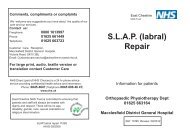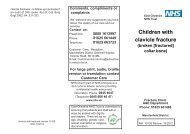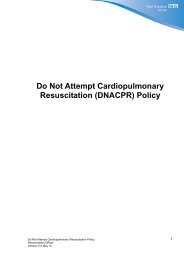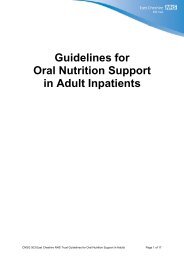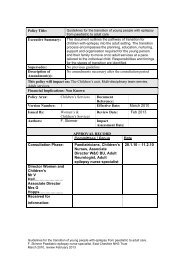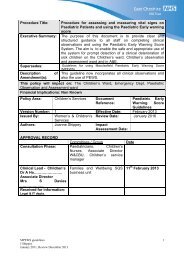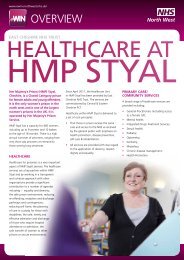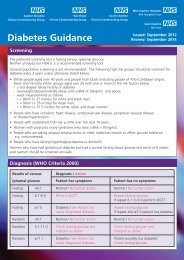Post death procedure - East Cheshire NHS Trust
Post death procedure - East Cheshire NHS Trust
Post death procedure - East Cheshire NHS Trust
Create successful ePaper yourself
Turn your PDF publications into a flip-book with our unique Google optimized e-Paper software.
handling policy.) Remove all put one pillow.Support the jaw by placing a pillow or rolled uptowel on the chest underneath the jaw.Remove any mechanical aids such as syringedrivers, heel pads, etc. Apply gauze and tapeto syringe driver sites and document actions innursing documentation. Straighten limbs.Close the patient’s eyes by applying lightpressure to the eyelids for 30 seconds.Drain the bladder by pressing on the lowerabdomen.Pack orifices with gauze if fluid secretioncontinues or is anticipated. If excessiveleaking of bodily fluids occurs, considersuctioning.Exuding wounds should be covered with cleanabsorbent dressing and secured with anocclusive dressing (e.g. Tegaderm)Remove drainage tubes etc., unless otherwisestated. Open drainage sites may need to besealed with an occlusive dressing. (e.g.Tegaderm)Wash the patient unless requested not to doso for religious or cultural reasons (pleaserefer to section on individual faiths in this file).If necessary shave a male patient.2 – 6 hours after <strong>death</strong> with full intensity within48 hours and then disappearing within another48 hours.To maintain patient dignity and for aestheticreasons. Closure of eyes will also provide tissueprotection in case of corneal donation.Because the body can continue to excrete fluidsafter <strong>death</strong>.Leaking orifices pose a health hazard to staffcoming into contact with the body.The dressing will absorb any leakage from thewound site. Open wounds pose a health hazardto staff coming into contact with the body. If apost mortem is required existing dressing shouldbe left insitu and covered.Open drainage sites pose a health hazard tostaff coming into contact with the body. If a postmortem is required drainage tubes etc., shouldbe left insitu.For hygienic and aesthetic reasons. As a markof respect and a point of closure in therelationship between nurse and patientIt may be important to family or carers to assistwith the washing, to continue to provide thecare given in the period before the <strong>death</strong>Clean patient’s mouth with a foam stick toremove any debris and secretions. Cleandentures and replace them in the mouth ifpossible.Remove all jewellery, in the presence ofanother nurse, unless requested by thepatient’s family to do otherwise. Jewelleryremaining on the patient should bedocumented on the ‘notification of <strong>death</strong>’ form.Record the jewellery and other valuables inthe patient’s property book and store the itemsaccording to local policy.Dress the patient in personal clothing or ashroud, depending on hospital policy orpartner / relatives wishes.Label one wrist and one ankle with anidentification label. Complete any documentssuch as notification of <strong>death</strong> cards. Copies ofsuch cards are usually required (refer tohospital policy for details). Tape one securelyto shroud.It is an expression of respect and affection, partof the process of adjusting to loss andexpressing grief.For hygienic and aesthetic reasons. To maintainprivacy and dignity.To meet with legal requirements and partner /relatives wishes.(See Section 4 - lilac section)For cultural or religious reasons and to meetwith family’s and / or carers wishes.To ensure correct and any easy identification ofthe body in the mortuary.Wrap the body in a mortuary sheet , ensuring To avoid possible damage to the body during6/34





